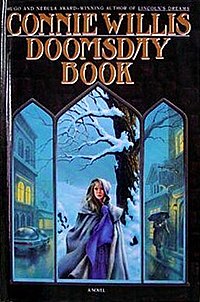Doomsday Book (novel)

First edition hardcover
|
|
| Author | Connie Willis |
|---|---|
| Country | United States |
| Language | English |
| Genre | Science fiction novel |
| Publisher | Bantam Spectra |
|
Publication date
|
1992 |
| Media type | Print (hardback & paperback) |
| Pages | 592 pages (paperback) |
| Awards | Locus Award for Best Science Fiction Novel (1993) |
| ISBN | (Hardcover) (Paperback) |
| OCLC | 24952289 |
| 813/.54 20 | |
| LC Class | PS3573.I45652 D66 1992 |
Doomsday Book is a 1992 science fiction novel by American author Connie Willis. The novel won both the Hugo and Nebula Awards, and was shortlisted for other awards. The title of the book refers to the Domesday Book of 1086; Kivrin, the main character, says that her recording is "a record of life in the Middle Ages, which is what William the Conqueror's survey turned out to be."
The novel is the first in a series about the Oxford time-traveling historians, which includes To Say Nothing of the Dog (1998) and Blitz (2010).
Willis imagines a near future (first introduced in her story "Fire Watch" (1982)) in which historians conduct field work by traveling into the past as observers. The research is conducted at the University of Oxford, in the late-21st century England.
In the book's fictional universe, history resists time travel that would cause the past to be altered, by preventing visits to certain places or times. Typically the machine used for time travel will refuse to function, rendering the trip impossible. In other cases "slippage", a shift in the exact time target, occurs. The time-traveler arrives at the nearest place-and-time suitable for preventing a paradox; variance can be anything from 5 minutes to 5 years. Some periods theoretically accessible can also be deemed too dangerous for the historians by the authorities controlling time travel.
Kivrin Engle, a young historian specializing in medieval history, asks her reluctant instructor (and father figure), Professor James Dunworthy, and the authorities running the project to send her to Oxford in 1320. This period had previously been thought too dangerous, because it stretched the time travel net 300 years earlier than it had ever been used before. Professor Gilchrist, who took charge of the project in the absence of the normal department head, coaxes authorities to allow it, in hopes it would enhance his own prestige, skipping numerous protocols to ensure her safety. Kivrin will be the first historian to visit the period and is confident that she is well prepared for what she will encounter.
Shortly after sending Kivrin to the 14th century, Badri Chaudhuri, the technician who set the time travel coordinates for Kivrin's trip, collapses suddenly, an early victim of a deadly new influenza epidemic that then disrupts the university and eventually leads to the entire city's being quarantined. The time traveler Kivrin also falls ill as soon as she arrives in the past. She awakens, after several days of fever and delirium, at a nearby manor, whose residents have nursed her. Being moved by her rescuers caused her to lose track of where the "drop point" is (in order to return home, she must return to the exact location where she arrived, when the gateway opens at a prearranged time).
...
Wikipedia
